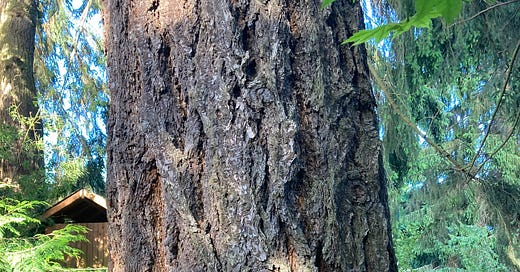Trees seduced my wife and me into buying our house. In 1998, we moved to Seattle, where I had grown up. Like most people, we made the home tour scene, seeing the good, the bad, and the truly ugly. Who would want an all-black (all fixtures, too) bathroom? Then one day, our agent sent us to a neighborhood well outside of my youthful experiences. Plain from the outside with a grass front yard, a lone crabapple, and three sad-looking rhododendron, the house was equally as unadorned inside with renter’s-white walls and tan carpets. But the backyard was beyond compare: three magnificent Douglas firs, the biggest of which we couldn’t wrap our arms around.
Six weeks later we moved in and have never regretted it. Because of the Douglas firs, I have heard the eerie, piercing whistle of varied thrushes, watched mallards paddle about our flooded garage roof under the trees, and reveled in the brilliant yellow flits of Wilson’s warblers. I have wondered about the stories shared as brown creepers ascend the trees and red-breasted nuthatches descend them. I have watched raccoons and opossums, western tiger swallowtails and mourning cloak butterflies, and a host of arachnids, which ply the bark hunting meals and building nests.
But in the past few years, our trees and ones in our neighbor’s yard have played host to a new pair of species. For several winters, bald eagles have roosted in the Douglas firs. They arrive around sundown, spend the night, and head out early in the morning. We often see them but even when we don’t they make their presence clear by calling in that one-of-a-kind unctuous squeaky wheel sound they make. It is quite a pleasure to have a bald eagle as your alarm clock.
We also have been lucky enough to have regular visitations from Cooper’s hawks. For several years, they nested a couple houses away from us and regularly landed in our trees. One day after work my wife and I were sitting in the backyard under our trees when two Cooper’s hawks flew through the yard and landed about 20 feet from us in one of our yard’s Douglas firs. The birds sat for a bit, looked toward us, ignored us, and then took off. Their presence immediately took the edge off what had been a long day. Another time I watched the female eat a rat, closely watched by her mate. I later found the rodent’s skull at the base of the tree. I have also found feathers from birds such as rufous sided towhees, as well as retched up pellets brimming with feathers, fur, and bones. Nature and her tooth and claw in our little backyard.
Several years ago, one of our neighborhood Cooper’s hawks was banded in September. Two weeks later he showed up in another backyard on Beacon Hill and the next day in Medina. Another Cooper’s hawk, banded in Volunteer Park in late July, ended up Oakland, California, three months later. What I might call my Cooper’s hawks, or you might call yours, are certainly much more than that. We are merely lucky enough to lay a small, and rather tenuous, claim on birds that travel far and depend upon good habitat in numerous locations.
I am not alone in these encounters. There are at least 76 eagle nests, which can weigh as much as 100 pounds, in private and public spaces across the county. Because of this distribution, the birds are regularly seen across Seattle. For example, several years ago I was talking to a group about Seward Park’s unique geology when I saw a bald eagle swoop down upon a duck in Lake Washington. I stopped my chattering and we all watched as the symbol of our country attempted to nab lunch. I think I was only one who wanted the eagle to succeed. Later that same week we also saw several eagles standing on the sand at low tide at Discovery Park, looking like miniature lighthouses.
The Cooper’s hawks are also plentiful. In 2015, researchers located 46 nesting attempts and 40 successful nests, which translated to 145 young that survived to fly in Seattle. The most common nest trees are bigleaf maple, Douglas fir, madrona, and western white pine. Most of the nests were in public parks and greenbelts and the rest in private yards or the UW campus.
I can only imagine the impact of each of these nests and their inhabitants on the people who live nearby. They get to see these beautiful birds and hear their calls. They may see the birds hunting, eating, and mating. They get to encounter wildness in the landscape often considered the most devoid of wildness: a large metropolis. And through these encounters, I like to think they have fuller, more interesting lives. I know that my wife and I certainly do and that we feel especially blessed because of the nature of our own backyard.
As a follow up to my newsletter last week about terra cotta figures, I have learned the fate of several more. One was destroyed during the removal process. Two ended up in Mukilteo, in a backyard and on a chimney. Another is in Buhl, Idaho, owned by someone in the Seattle demolition who acquired it back in the day and took it to his property in Idaho. Another purchaser was W.E. Boeing Jr. though I have no idea whether his descendants still own the figure. I was also sent a piece of art inspired by the figures; the technique is called rug hooking. I think it’s pretty darned nifty.








Amazing Doug fir—and even cooler that you have your own eagles and hawks!! I read somewhere that the first urban eagle’s nest in Seattle was found in only 1980 at Seward Park (which feels relatively recent). I still see a pair of eagles there whenever I go by, usually perched on one of the tallest Doug firs. They pick their homes well.